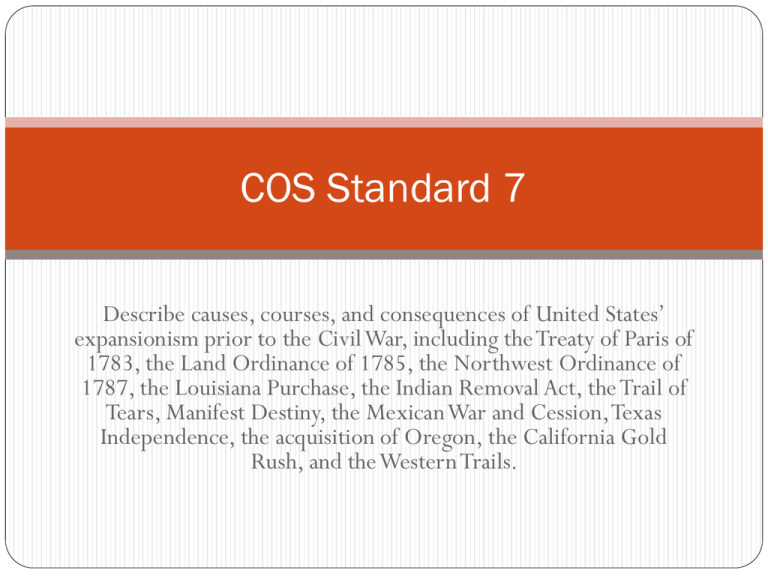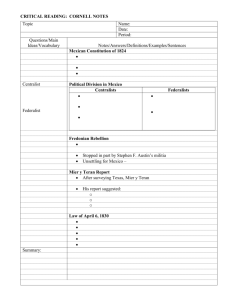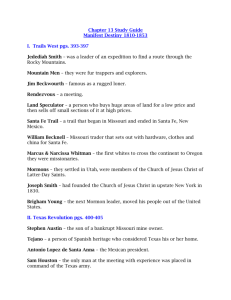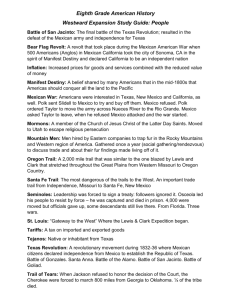COS Standard 7
advertisement

COS Standard 7 Describe causes, courses, and consequences of United States’ expansionism prior to the Civil War, including the Treaty of Paris of 1783, the Land Ordinance of 1785, the Northwest Ordinance of 1787, the Louisiana Purchase, the Indian Removal Act, the Trail of Tears, Manifest Destiny, the Mexican War and Cession, Texas Independence, the acquisition of Oregon, the California Gold Rush, and the Western Trails. Treaty of Paris 1783 Treaty that ended American Revolution, signed September 3, 1783 America dominates North America America gives France colonies in the Caribbean and Africa. Britain gives Spain Florida. Britain must recognize the US as a new nation with the Mississippi River as its western border. Treaty of Paris 1783 Land Ordinance of 1785 Old Northwest to be sold to pay for national debt Sets up how towns should look Northwest Ordinance of 1787 Northwest Ordinance of 1787: determines how a territory becomes a state Provides a framework to govern the territory 60,000 people must live in a territory before it can become a state Bans slavery Louisiana Purchase In 1803, Thomas Jefferson sent James Monroe to meet Robert Livingston (a diplomat already in France). They were instructed to buy New Orleans and as much land as they could get for $10 million. If negotiations failed, they were instructed to form an alliance with Britain. (France and Britain were at war.) Napoleon decided to sell all of Louisiana to America. Napoleon failed to reconquer Santo Domingo: sugar. His attempt to take over Europe was taking too long, so he sold it to America, instead of later giving it to England. Louisiana Purchase continued Livingston started negotiations and told France he could buy the territory for $15 million. Jefferson was startled by the news. Is this legal? Did Jefferson have the authority to sign a treaty with another country that gives America land? NO It didn’t matter. America wanted LAND! Significance: doubles the size of the US $0.03 an acre Napoleon and Robert Livingston Louisiana Purchase Exploring Louisiana Thomas Jefferson funded an expedition of the newly acquired land. Meriwether Lewis and William Clark explored from St. Louis to the Pacific Coast. Sacagawea was their guide. The trip expanded the knowledge of the territory, as well as laid claim to the Oregon territory. Lewis, Clark and Sacagawea Indian Removal Act: 1830 Andrew Jackson hated Native Americans. He supported the idea of moving all the Native Americans to the Great Plains. Indian Removal Act: gave funds to relocate the Native Americans. Cherokee do not want to move. Jackson forcible removes them on the Trail of Tears. Thousands of Cherokee die on the journey to Oklahoma. Trail of Tears Manifest Destiny John Louis O’Sullivan The idea that God gave America to us and we should settle it from the Atlantic Ocean to the Pacific Ocean. Acquisition of Oregon Britain and America both vie for Oregon. Why? Americans do not want to settle in the Great Plains. They thought it had poor farm land. Missionaries settle Oregon to convert Native Americans. James K. Polk runs for president. In public his campaign slogan is “Fifty-four Forty or Fight.” In private, Polk makes a deal with Britain to draw the boundary line at the 49 north latitude line. Oregon and James K. Polk California Gold Rush Starts in 1848, by 1849 the rush is on “Forty-Niners” Need a government to maintain order, California applies for statehood. Has enough people to skip the territory stage and immediately applies for statehood. Free state Confronts slavery issue Western Trails Oregon Trail Donner Party Mormon Trail: Utah California Trail Santa Fe Trail: New Mexico Texas Independence Texas was part of Mexico. Mexico opened Texas to Americans to settle. At first, Americans agreed to be Mexican citizens, but not adopt Mexican customs. Haden Edwards attempted to take over Texas and rename it Fredonia. Stephen Austin stopped Edward’s revolt. In 1830, Mexico closed its borders to American immigrants, banned slavery and discouraged trade with the US. People in Texas were angered by the change in Mexico. America attempts to talk Mexico to get them to reopen their borders. Texas Independence continued A convention was set up to separate Texas from Mexico. They wrote a constitution and sent Austin to negotiate with the Mexican government. Negotiations failed. Austin wrote a letter suggesting Texas should organize their own state government. The letter Austin wrote was intercepted, he was arrested and jailed. When he was released from jail, Austin urged Texans to organize an army. Meanwhile, Antonio Lopez de Santa Anna, president of Mexico, makes himself the dictator of Mexico. Texas’s first victory was at Gonzales. Sam Houston took command of the Texas army. Texas Independence continued At the Alamo, Santa Anna met 180 Texan rebels. William Travis joined by 32 settlers held off Santa Anna for 13 days. Santa Anna’s army defeated the Texan forces. In the meantime, Texas declared independence from Mexico. At Goliad, the Texans lost and Santa Anna executed over 300 Texans. At San Jacinto, Houston launched a surprise attack. They captured Santa Anna, who was forced to sign a treaty giving Texas their independence. Sam Houston was elected the president of the Republic of Texas. They applied for annexation to be a slave state (controversial). Alamo, Stephen Austin, Sam Houston and Santa Anna Mexican War and Cession When Mexico refused to discuss the purchase of California, President Polk sent troops to cross the Nueces River. Mexico sees this as an invasion of their country. Mexico attacks. The Mexican War started. Zachary Taylor and his troops attacked the Mexican army on four occasions and won. John Fremont fought in northern California. On June 14, 1846, the settlers in California declared independence from Mexico. Despite the defeats in Mexico and California, the Mexican army refused to surrender. Mexican War and Cession continued Winfield Scott replaced Zachary Taylor. Scott captured Mexico City on September 14, 1847. On February 2, 1848, the Treaty of Guadalupe Hidalgo was signed ending the Mexican War. Mexico gave up land in California, Utah, Nevada, New Mexico, Arizona, Colorado and Wyoming. Also, the new border of Texas became the Rio Grande. America agrees to pay Mexico $15 million and assume $3.5 million in Mexican debts. Significance: opens land to American settlers. The impact of Expansion on America: slavery became an issue. Zachary Taylor and John C. Fremont Treaty of Guadalupe Hidalgo






